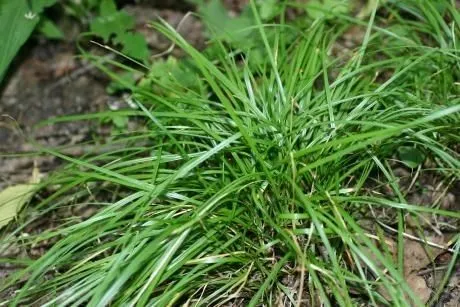
Author: Schwein.
Bibliography: Ann. Lyceum Nat. Hist. New York 1: 67 (1824)
Year: 1824
Status: accepted
Rank: species
Genus: Carex
Vegetable: False
Observations: S. Ontario to C. & E. U.S.A.
Grass sedge, known by its scientific name Carex jamesii, is a perennial plant belonging to the Cyperaceae family. First described by the botanist Schrader in 1824 in the Annals of the Lyceum of Natural History of New York, this species has captured the interest of botanists and ecologists for its particular adaptations and ecological significance.
Carex jamesii is indigenous to a broad swathe of North America, ranging from southern Ontario in Canada, traversing central regions, and extending to the eastern parts of the United States. This extensive distribution attests to its adaptability to diverse environmental conditions.
The plant typically thrives in rich, moist woodlands and shaded areas, favoring well-drained soils that are rich in organic matter. It is often found in deciduous forests where the canopy provides a moderate to dense cover, which is essential for its growth. Grass sedge features tufted, grass-like foliage that can blend seamlessly with surrounding grasses and other ground-cover plants, which contributes to its generally inconspicuous but vital role in forest ecosystems.
Aside from its ecological role, Carex jamesii is valued for its contribution to the biodiversity of forest undergrowth layers, providing habitat and food for various insects and small wildlife. Its presence enriches the soil quality by preventing erosion and enhancing nutrient cycling through its root systems.
This particular sedge serves as an important indicator of healthy, undisturbed forest ecosystems, making it a species of interest for conservationists and ecologists monitoring the health of woodland areas. Its ecological benefits, coupled with its adaptability, make Grass sedge a noteworthy species to study and preserve within its native range.
Eng: james’ sedge, grass sedge
Fra: carex de james
En: Grass sedge, James’ sedge
Zh: 二籽苔草
Fr: Carex de James
Fa: کارکس جامسی
Zh-hant: 二籽苔草
Taken Nov 15, 2022 by shannon felger (cc-by-sa)
Taken Jul 8, 2022 by helen c (cc-by-sa)
Taken Jan 1, 1900 by EOL − John Hilty (cc-by-nc)
Taken Aug 12, 2010 by EOL − Kirchner, Natalie (cc-by-nc-sa)
Taken Aug 12, 2010 by EOL − Kirchner, Natalie (cc-by-nc-sa)
Taken Jan 1, 1900 by EOL − John Hilty (cc-by-nc)
Taken Aug 12, 2010 by EOL − Kirchner, Natalie (cc-by-nc-sa)
Growth habit>: Graminoid
Family: Myrtaceae Author: (F.Muell.) K.D.Hill & L.A.S.Johnson Bibliography: Telopea 6: 402 (1995) Year: 1995 Status:…
Family: Rubiaceae Author: Pierre ex A.Froehner Bibliography: Notizbl. Bot. Gart. Berlin-Dahlem 1: 237 (1897) Year:…
Family: Sapindaceae Author: Koidz. Bibliography: J. Coll. Sci. Imp. Univ. Tokyo 32(1): 38 (1911) Year:…
Family: Asteraceae Author: A.Gray Bibliography: Pacif. Railr. Rep.: 107 (1857) Year: 1857 Status: accepted Rank:…
Family: Fabaceae Author: Medik. Bibliography: Vorles. Churpfälz. Phys.-Ökon. Ges. 2: 398 (1787) Year: 1787 Status:…
Family: Aspleniaceae Author: (Cav.) Alston Bibliography: Bull. Misc. Inform. Kew 1932: 309 (1932) Year: 1932…